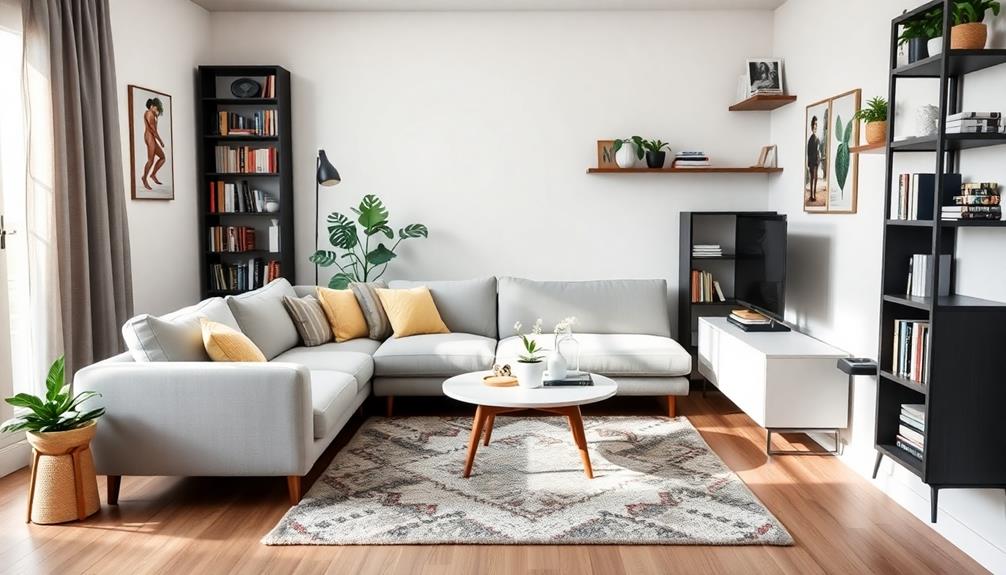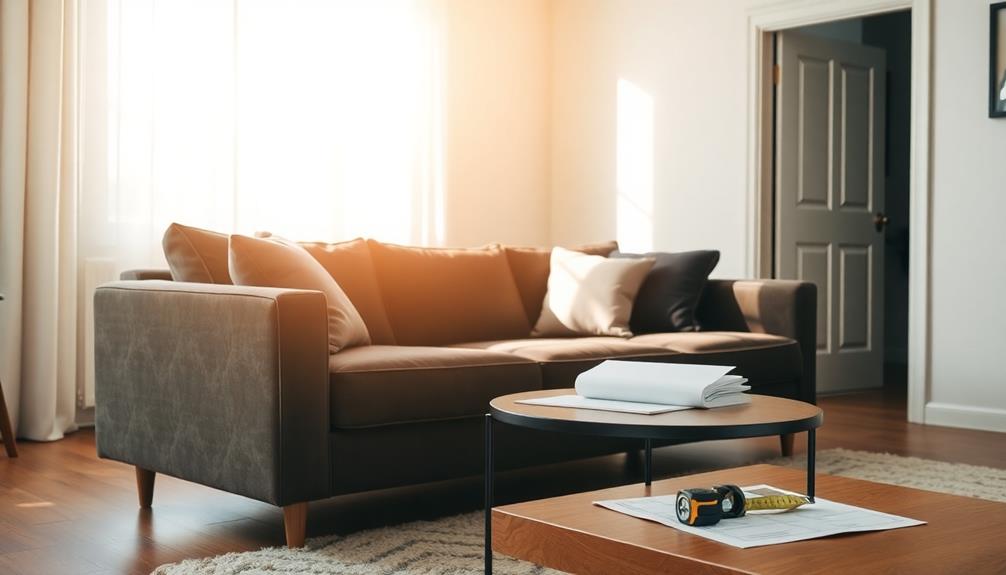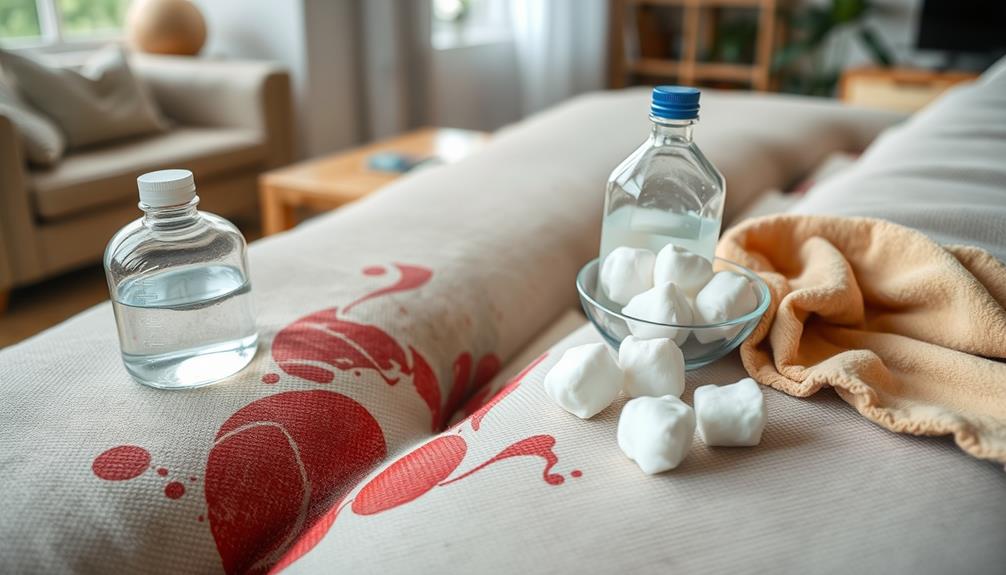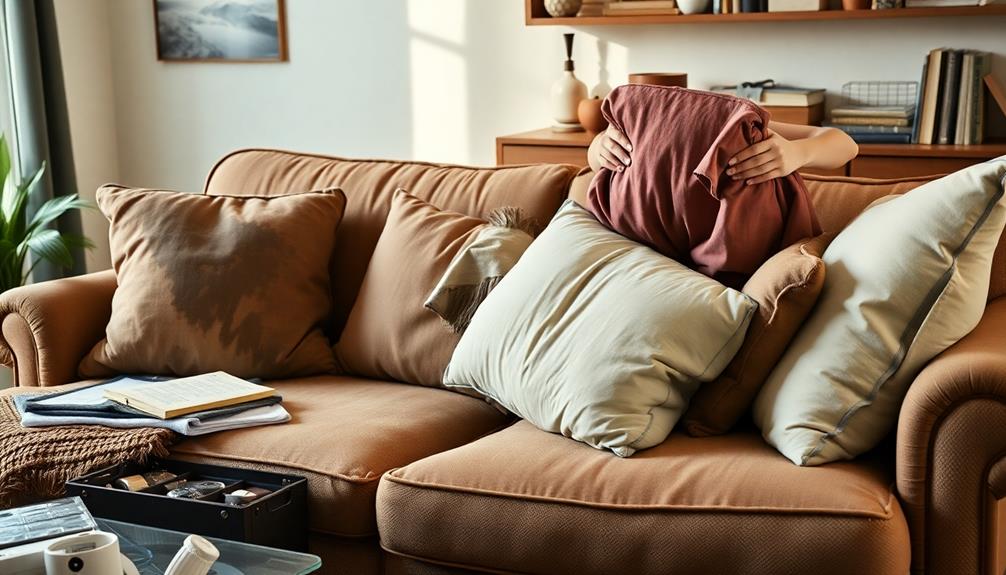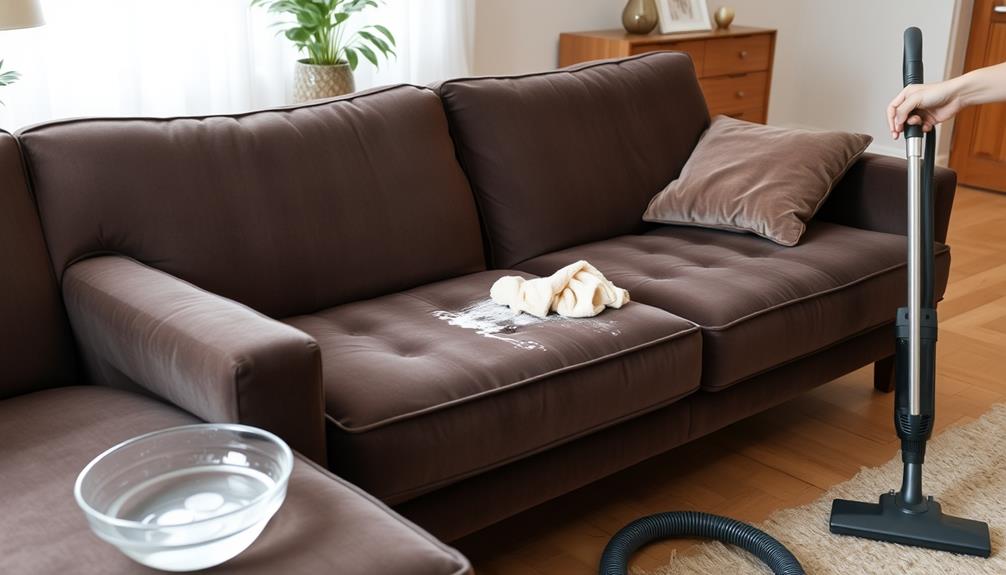When arranging furniture in a small living room, it is important to start by determining its purpose. Select a layout that establishes a central gathering area, moving furniture away from the walls and allowing for clear pathways of at least 30 inches. Consider using multi-functional pieces such as sofa beds and nesting tables to make the most of the space. Don’t overlook the vertical space – utilize tall shelves and wall-mounted storage. Place furniture near windows to make the most of natural light, and incorporate different textures with various materials for added visual appeal. Keep the space organized and free from clutter to maintain a welcoming atmosphere. For more tips on maximizing your space, continue reading! You can also strategically use mirrors to reflect light and create the illusion of a larger space. When arranging furniture in your bedroom, follow similar principles by incorporating compact storage solutions like under-bed drawers and wall-mounted lighting to create more floor space. With careful selection and placement of each piece, you can make even the smallest rooms feel spacious and practical.
Key Takeaways
- Define the living room's primary purpose to prioritize seating and pathways for movement and social engagement.
- Choose a cozy L-shaped layout to optimize space and enhance interaction among guests.
- Maintain 30 inches of clear pathways and position furniture to create a central gathering area.
- Select multi-functional furniture like sofa beds and nesting tables to maximize usability without overcrowding.
- Utilize vertical space with tall shelves and mirrors to enhance the perception of openness and light.
Define Your Living Room's Purpose
Before you immerse yourself in furniture placement, it's vital to define your living room's purpose. Understanding whether you want the space for watching TV, hosting conversations, or a combination of both will guide your furniture arrangement decisions.
Think about how often you'll use it for different activities. If you frequently host gatherings, prioritizing ample seating and clear pathways for movement is fundamental. Additionally, creating a fascinating narrative around the space can enhance how you envision its functionality, inspiring unique charm in your design choices.
Consider the needs of everyone in your household. A versatile layout is perfect for accommodating relaxation, work, or play.
You might want to create a cozy conversation area that encourages interaction, or if watching movies is your priority, make sure seating faces the TV or fireplace.
Choose the Right Layout
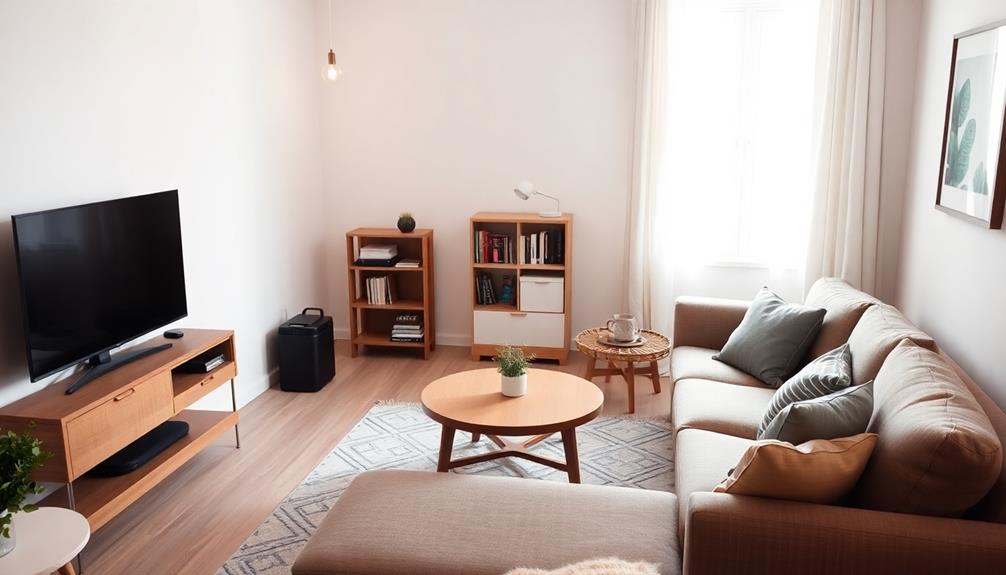
When it comes to your small living room's layout, choosing the right arrangement can make all the difference. A well-planned Living Room Layout not only enhances aesthetics but also improves functionality.
Consider incorporating elements from DIY Fire Pit Ideas to create a cozy atmosphere. An L-shaped sofa arrangement is one effective layout; it optimizes seating while allowing easy movement and conversation flow.
You might also consider a symmetrical layout. Placing two armchairs opposite a sofa creates balance and defines a focal point, making the space feel more inviting.
Multi-functional furniture arrangements, like ottomans or coffee tables with hidden storage, can maximize usability without overcrowding your room.
Don't forget about the importance of Visual Weight in your layout. Placing furniture away from walls creates a central gathering area, giving the illusion of a larger space while encouraging interaction among occupants.
Additionally, using rugs can visually separate functional zones, helping to define areas for conversation or relaxation without physical barriers.
Optimize Furniture Placement
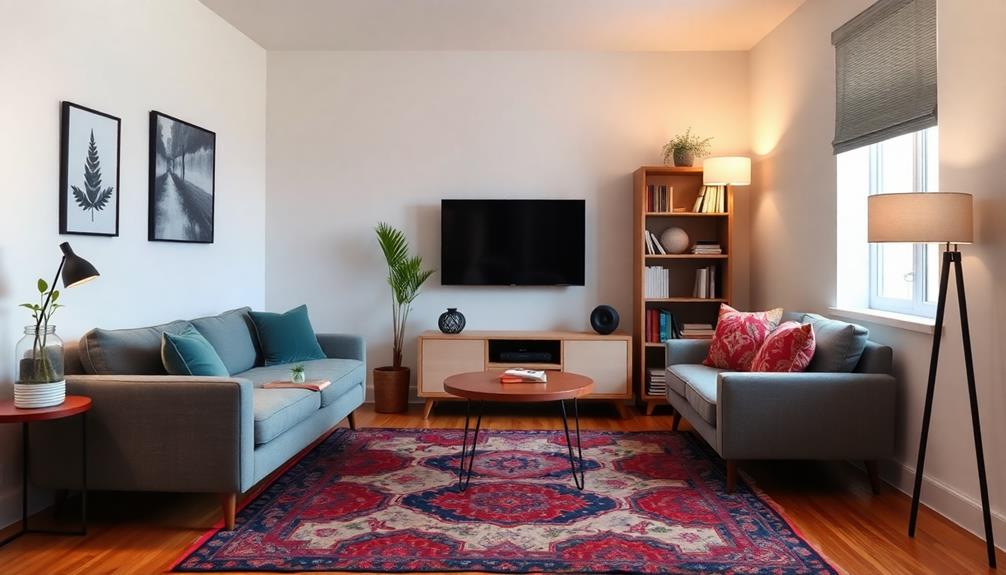
To optimize furniture placement, start by pulling pieces away from the walls to create a central gathering area that invites conversation.
Consider the importance of support resources for caregivers when arranging a space for seniors, as it can enhance their comfort and social interaction.
Make sure to leave at least 30 inches for clear pathways, ensuring everyone can move freely.
Using armchairs can help define these conversation spaces while keeping your layout flexible and open.
Central Gathering Area
Creating a central gathering area in your small living room can transform the space into a cozy hub for conversation and connection. Start by pulling furniture pieces away from the walls, which encourages interaction and makes the area feel inviting. Strategically place armchairs to define conversation spaces, allowing everyone to engage comfortably. This arrangement not only enhances social engagement but also creates a more dynamic layout.
Make sure to designate clear traffic paths around your furniture, ensuring at least 30 inches of space for smooth flow and accessibility. This will help avoid any feelings of clutter or obstruction in your small living room.
Keep in mind that pathways from entrances to seating areas should remain unobstructed, providing a welcoming layout that facilitates movement.
To maintain an open feel, avoid oversized furniture that disrupts flow. Instead, opt for smaller, multi-functional pieces that can be easily rearranged or stored when not in use.
Clear Pathways Required
A small living room thrives on clear pathways that facilitate movement and accessibility. To create an inviting and functional space, consider the following:
- Maintain 30 to 36 inches between large furniture pieces to guarantee clear pathways for easy navigation.
- Position your coffee table at least 12 to 16 inches from the sofa, allowing comfort while preserving flow.
- Opt for lightweight side tables instead of bulky options, enhancing flexibility and movement throughout the room.
Designate traffic paths around your furniture, creating a seamless flow from entrances to seating areas. Avoid placing items that disrupt this flow, and strategically position your armchairs to define conversation areas without blocking pathways.
By prioritizing clear pathways, you not only enhance the functionality of your small living room but also make it feel more spacious and welcoming. Remember, the goal is to guarantee that everyone can move freely while enjoying the cozy atmosphere you've created.
With thoughtful furniture placement and a focus on accessibility, you'll transform your small living room into a beautifully arranged haven.
Armchairs for Conversations
Armchairs positioned across from each other instantly foster an intimate conversation area, making it easy for you and your guests to engage. This setup encourages eye contact and creates a welcoming atmosphere, perfect for meaningful discussions.
Instead of opting for a large sofa, consider using pairs of armchairs to maximize seating while maintaining an open space. This arrangement not only enhances comfort but also keeps the room feeling airy.
To guarantee everyone's movement is unhindered, maintain a clear pathway of at least 30 inches between your armchairs and other furniture. This allows for easy access and prevents the area from feeling cramped.
Choose lightweight, movable armchairs that can be easily rearranged to suit different social gatherings; this flexibility adds to the room's functionality.
Incorporating side tables next to your armchairs is essential for enhancing usability. They provide a space for drinks or decorative items, all while making certain the conversation flow remains uninterrupted.
Ultimately, thoughtful placement of armchairs and side tables transforms your small living room into a cozy retreat, perfect for engaging conversations and shared moments.
Select Multi-Functional Pieces
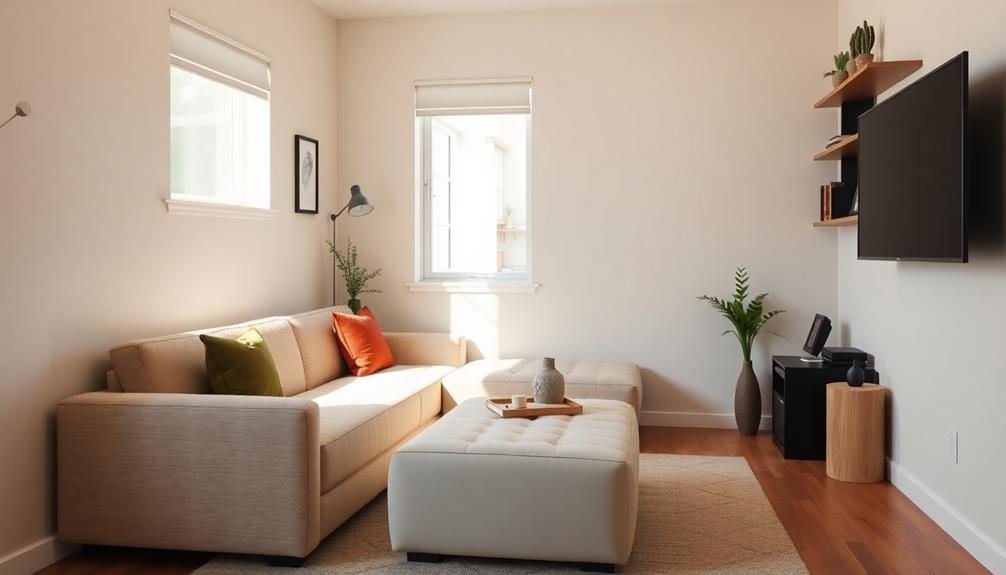
Selecting multi-functional pieces is essential for maximizing the utility of a small living room. When your space is small, every item should serve more than one purpose. Here are three fantastic options to contemplate:
- Sofa Bed: A stylish sofa facing your TV can transform into a bed for guests, saving you from needing extra sleeping arrangements.
- Nesting Tables: These handy tables can be pulled out for snacks or drinks and easily tucked away when you need more floor space.
- Wall-Mounted Desk: A desk that folds away allows you to create a workspace without sacrificing valuable floor space, especially in smaller living rooms.
Incorporating these multi-functional pieces not only enhances the functionality of your living area but also keeps it organized.
Look for lightweight armchairs that can be repositioned to accommodate different activities, whether you're entertaining or relaxing.
Contemplate coffee tables with compartments to store essentials, ensuring everything has its place while maintaining an open feel.
Maximize Vertical Space
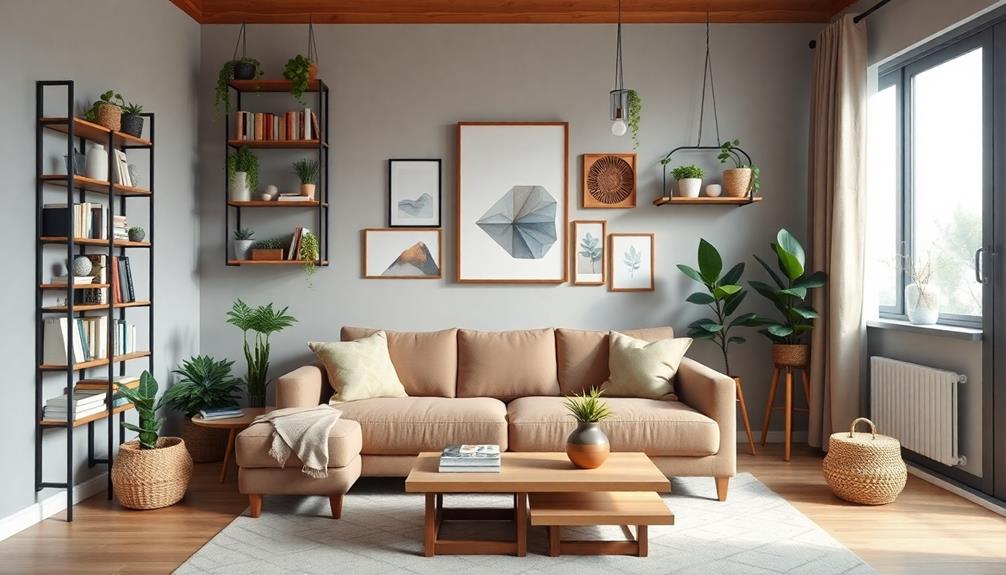
To make the most of your small living room, maximizing vertical space is key. Start by utilizing tall bookcases and shelves to draw the eye upward, creating an illusion of height while providing ample storage. Hang draperies close to the ceiling and let them fall to the floor; this enhances vertical space perception and promotes a more expansive feel.
Here's a quick guide to help you maximize vertical space effectively:
| Strategy | Benefit |
|---|---|
| Use tall bookcases | Increases storage while drawing the eye up |
| Incorporate wall-mounted lighting fixtures | Saves floor space and reduces clutter |
| Choose stackable storage options | Maintains flexibility without taking too much room |
Position larger furniture away from walls, creating defined zones in your living room. This arrangement allows you to utilize vertical storage solutions, keeping surfaces clear and organized. You'll find that these strategies not only maximize your space but also create a more inviting atmosphere. Embrace verticality, and transform your small living room into a stylish and functional area!
Utilize Natural Light
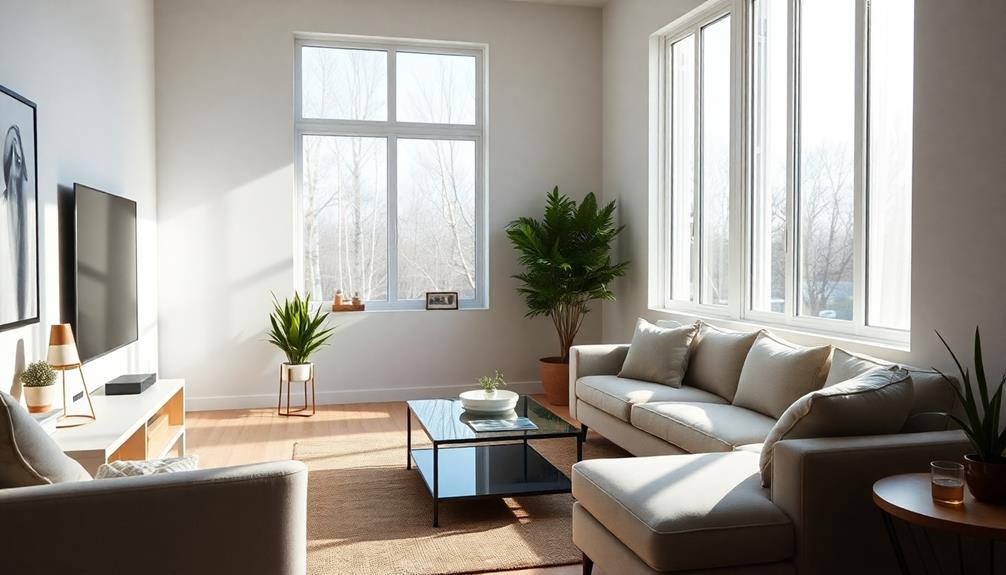
Arranging your furniture to take advantage of natural light can greatly enhance the atmosphere of your small living room. By maximizing exposure to sunlight, you'll create a brighter, more spacious feel in your living area.
Here are three effective strategies to utilize natural light:
- Position furniture near windows: Place your seating close to the windows to soak up the sunlight, which opens up the room.
- Opt for sheer window treatments: Choose light, airy curtains that allow natural light to filter through while ensuring your privacy, contributing to an inviting atmosphere.
- Incorporate mirrors: Strategically place mirrors opposite the windows to reflect natural light deeper into the room, enhancing brightness and creating an illusion of depth.
Additionally, consider using light-colored furnishings and an area rug that reflects natural light.
Avoid heavy drapery and dark colors, as they absorb light and can make your small living room feel more confined.
Incorporate Textures and Colors
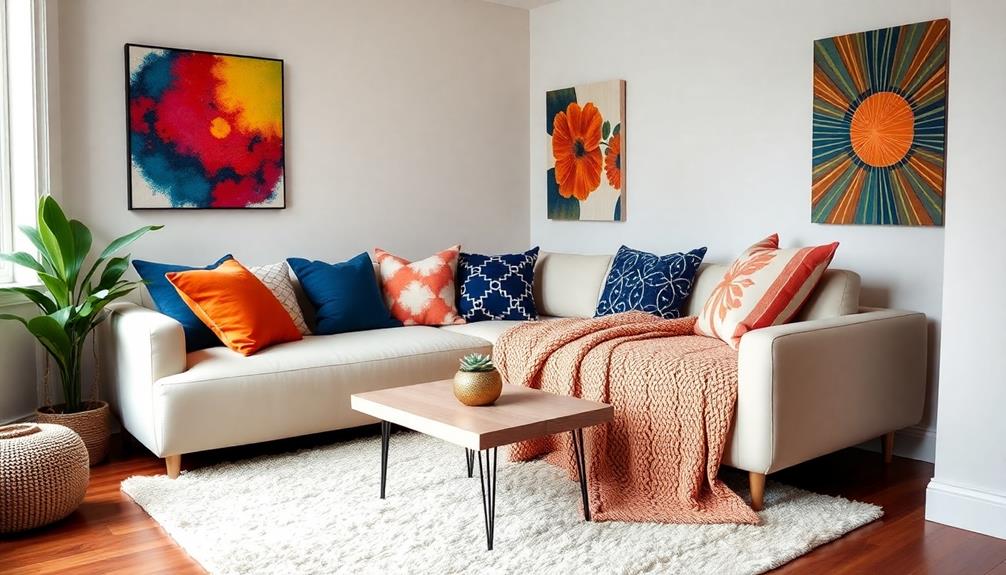
To make your small living room feel more inviting, layering textures is key; think plush cushions and woven fabrics that create depth.
Choosing the right color palette can transform the space, so opt for light neutrals and add vibrant accent pieces.
These elements not only enhance visual interest but also guarantee your room feels cohesive and stylish.
Layered Textures Add Depth
Frequently incorporating a mix of materials like wood, metal, and fabric can transform a small living room into a visually dynamic space.
Layered textures add depth and create visual interest, making your room feel inviting and stylish. Here are three effective ways to achieve this:
- Throw Pillows: Choose a variety of throw pillows in different fabrics, such as velvet, linen, and cotton, to enhance comfort and add layers to your seating areas.
- Area Rugs: Select area rugs with varied textures—like a plush shag next to a flatweave—to ground your furniture arrangement and visually separate different zones within the room.
- Woven Baskets: Use woven baskets for storage that also introduce natural textures, softening the overall aesthetic while keeping your space organized.
Additionally, don't forget about artwork; incorporating pieces with different textures, like canvas or mixed media, can elevate your walls and enhance the room's visual appeal.
Color Palette Choices Matter
Creating an inviting atmosphere in a small living room goes beyond just layering textures; the choice of color palette plays a significant role in shaping the space. Opting for a neutral and light color palette, like whites and creams, can make your living room appear larger and more open. These shades reflect natural light, enhancing the overall ambiance.
To add dimension without overwhelming the room, incorporate subtle accent colors through decor items, such as throw pillows or artwork. This approach keeps the atmosphere inviting and cohesive.
Light-colored furnishings with leggy designs help maintain an airy feel, allowing visibility of floor space and preventing a cramped look. Mixing materials like wood, metal, and fabric can create visual interest, while varied textures from woven baskets and different fabric types contribute to a layered aesthetic.
Additionally, consider incorporating mirrors strategically to enhance the perception of space. Mirrors reflect light and create depth, making your living area feel more expansive.
Accent Pieces for Interest
Incorporating a mix of textures and colors can really uplift your small living room and make it feel more dynamic. Accent pieces play a crucial role in achieving this effect, so make sure you choose wisely.
Here are three items to contemplate that work best for adding interest:
- Soft Throw Pillows: Layering different sizes and textures can create a cozy feel while adding color.
- Woven Blankets: Drape a textured blanket over your sofa or chair to invite warmth and comfort.
- Decorative Vases: Opt for vibrant colors or unique shapes to serve as focal points without overwhelming the area.
Don't forget to integrate natural elements, like potted plants, to introduce warmth and life.
Mirrors also work wonders as accent pieces, reflecting light and creating an illusion of more space.
Additionally, multi-functional furniture, such as ottomans that double as storage, can elevate your design while maximizing utility.
Keep It Organized and Clutter-Free
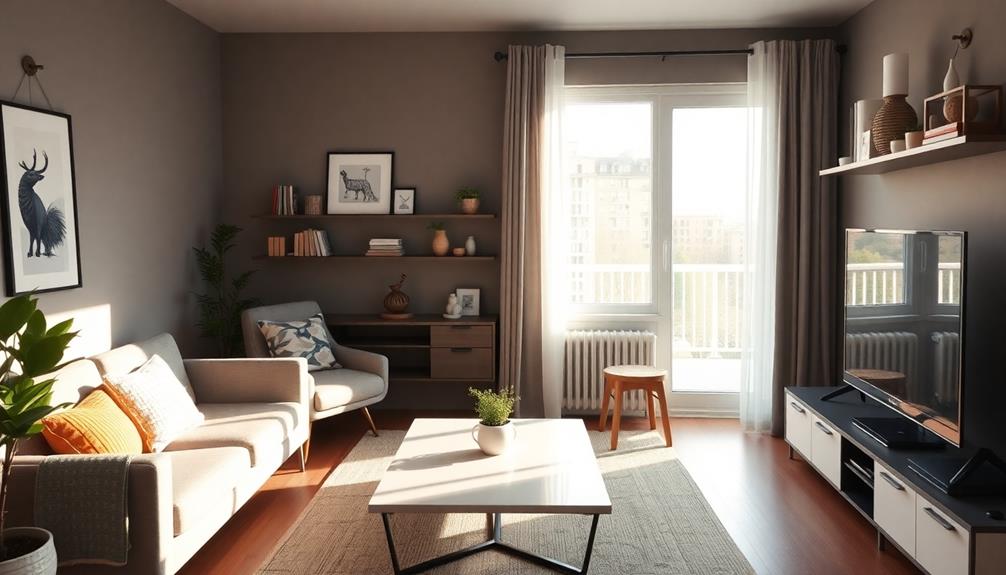
Keeping your small living room organized and clutter-free can transform it into a welcoming space. Start by regularly evaluating your items and decluttering, keeping only those that serve a purpose or bring you joy. This practice helps maintain an organized environment.
To enhance your storage options, incorporate decorative baskets and bins. They can store items out of sight, ensuring your surfaces remain clear and visually appealing. Implement a "one in, one out" rule; for every new item you bring home, remove an existing one. This simple strategy encourages a clutter-free atmosphere.
Consider using multi-functional furniture pieces, like ottomans with hidden storage, to maximize your space while keeping everything tidy. These versatile items not only provide seating but also help you organize your belongings efficiently.
Lastly, keep high-traffic areas free from clutter by designating specific spots for frequently used items. By doing so, you create a clean and organized aesthetic that makes your small living room feel larger and more inviting.
Frequently Asked Questions
How to Arrange Furniture in a Small Living Room With a TV?
To arrange furniture around your TV, position it on a wall opposite your main seating. Use compact, multi-functional pieces to maximize space, and create a cozy layout that encourages conversation while keeping pathways clear.
How Do You Set up a Couch in a Small Living Room?
Imagine your cozy space feeling open and inviting. You'll want to angle the couch slightly, place it against a wall, and guarantee you've got enough room to move around comfortably. It'll transform the area!
How to Arrange a Very Small Living Room?
To arrange a very small living room, you'll want to utilize multi-functional furniture, create flexible pathways, focus on a single focal point, and use mirrors and area rugs to enhance the space and organization.
How to Make a Small Room Look Bigger With Furniture?
Imagine stepping into a sunlit room, where light-colored furniture dances with the air. You've chosen multi-functional pieces, arranged them thoughtfully, and added mirrors to reflect warmth, making your small space feel expansive and inviting.
Conclusion
So, you thought arranging furniture in a small living room was a breeze, huh? Well, it's actually an art form! By defining your space's purpose and cleverly selecting multi-functional pieces, you can create a cozy oasis that feels spacious. Don't forget to maximize vertical space and let in that glorious natural light. With a little creativity and organization, you'll transform your tiny room into a stylish sanctuary. Who knew small living could be so grand?
